This is named after the clock fixed in 1851 to the gate of the Greenwich Observatory, known throughout the world for telling Greenwich Mean Time.
Framed prints and text about The Gate Clock.
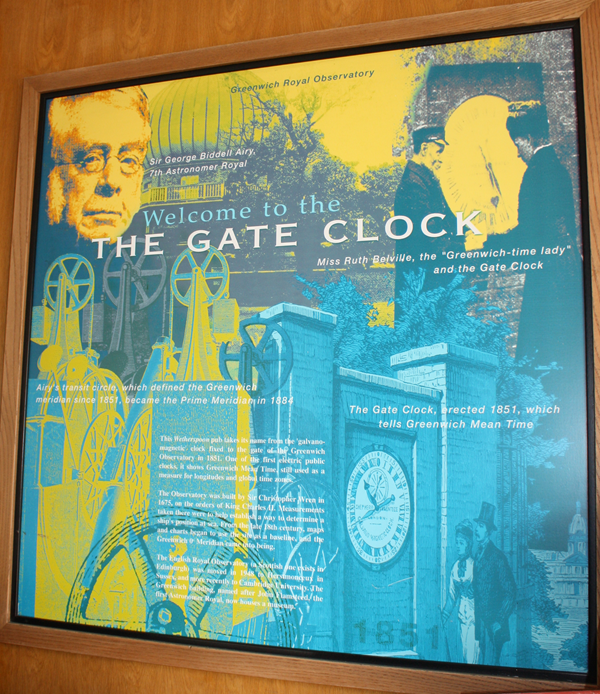
The text reads: This Wetherspoon pub takes its name from the ‘galvano -magnetic’ clock fixed to the gate of the Greenwich Observatory in 1851. One of the first electric public clocks, it shows Greenwich Mean Time, still used as a measure for longitudes and global time zones.
The observatory was built by sir Christopher Wren in 1675, on the orders of King Charles II. Measurements taken there were to help establish a way to determine a ship’s position at sea. From the late 18th century, maps and charts began to use the site as a baseline, and the Greenwich 0 degree meridian came into being.
The English Royal Observatory (a Scottish one exists in Edinburgh) was moved in 1948 to Herstmonceux in Sussex, and more recently to Cambridge University. The Greenwich building named after John Flamsteed, the first Astronomer Royal, now houses a museum.
A framed print showing Greenwich mean time.
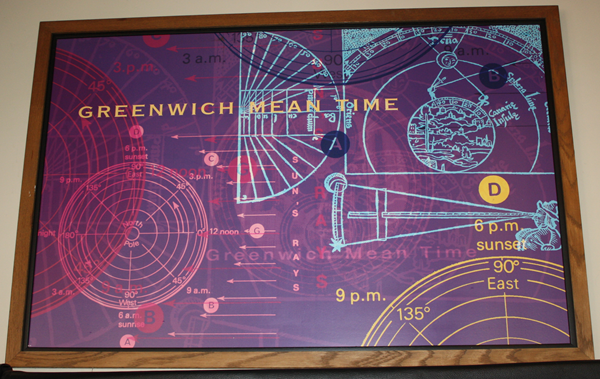
Framed prints and text about Nelson’s funeral.
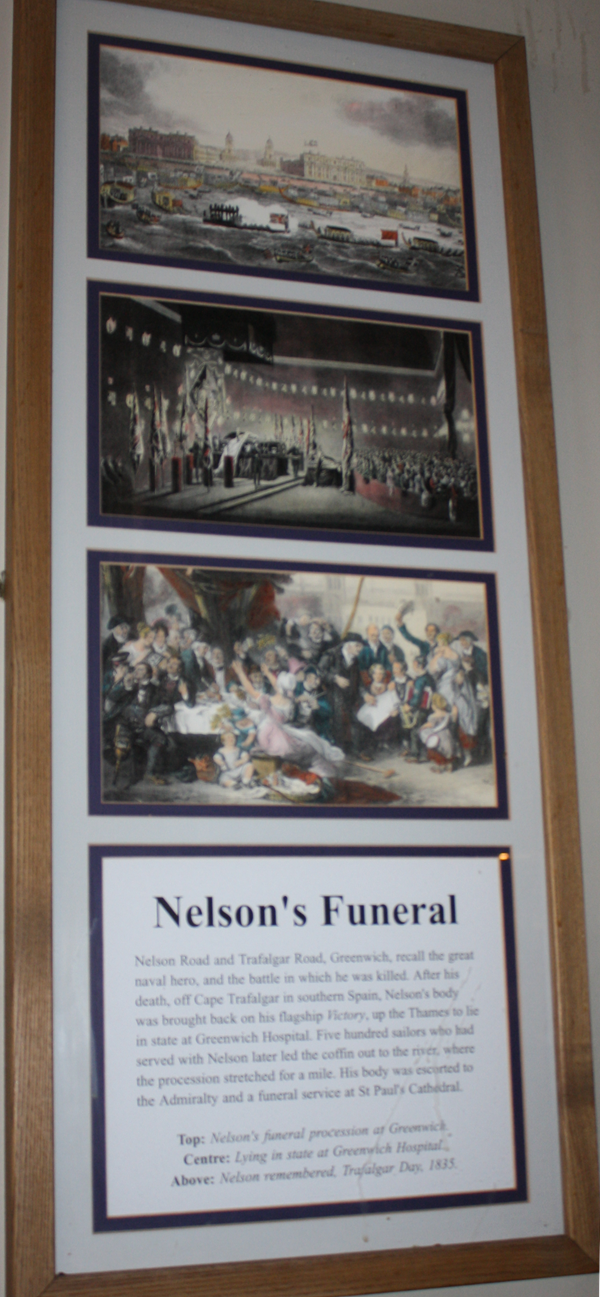
The text reads: Nelson Road and Trafalgar Road, Greenwich, recall the great naval hero, and the battle in which he was killed, After his death, off Cape Trafalgar in southern Spain, Nelson’s body was bought back on his flagship Victory, up the Thames to lie in state at Greenwich Hospital. Five hundred sailors who had served with Nelson later led the coffin out to the river, where the procession stretched for a mile. His body was escorted to the Admiralty and a funeral service at St Paul’s Cathedral
Top: Nelsons funeral procession at Greenwich
Centre: Lying in state at Greenwich Hospital
Above: Nelson remembered, Trafalgar Day. 1835.
Framed prints and text about transport in Greenwich.
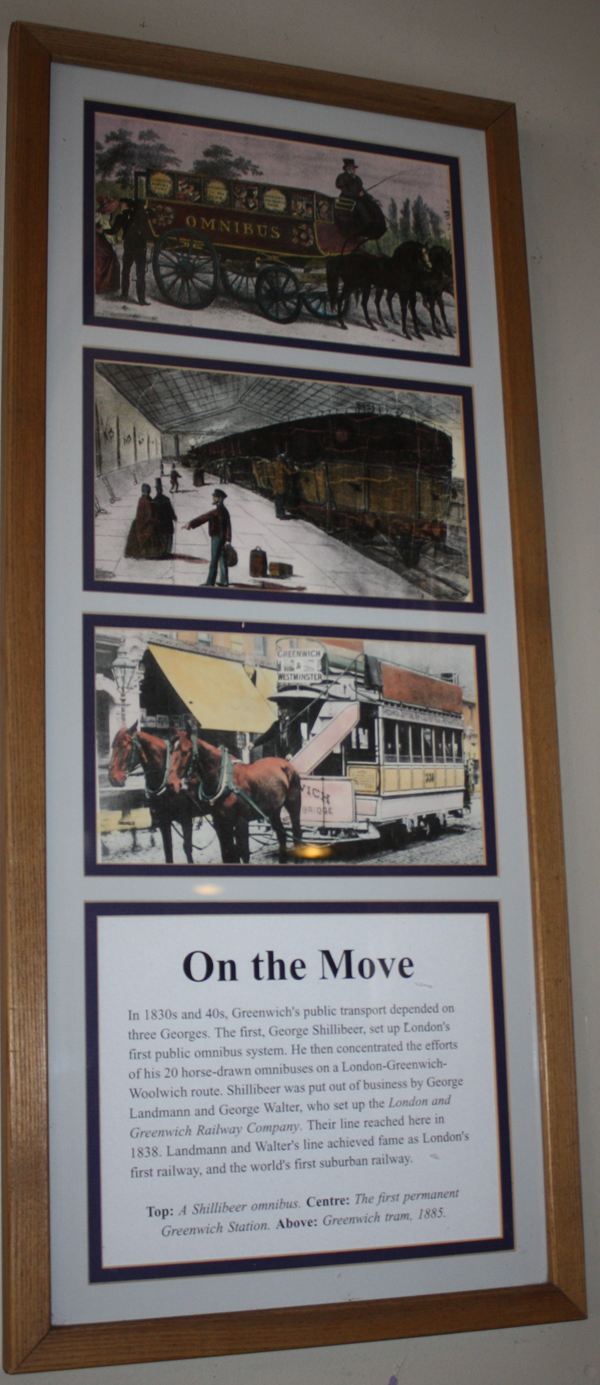
The text reads: In 1830s and 40s, Greenwich's public transport depended on three Georges. The first, George Shillibeer, set up London's first public omnibus system. He then concentrated the efforts of his 20 horse-drawn omnibuses on a London-Greenwich-Woolwich route. Shillibeer was put out of business by George Landmann and George Walter, who set up the London and
Greenwich Railway Company. Their line reached here in 1838. Landmann and Walter's line achieved fame as London's first railway, and the world's first suburban railway.
Top: A Shillibeer omnibus
Centre: The first permanent Greenwich Station
Above: Greenwich tram, 1885.
Framed prints and text about the Greenwich palaces.
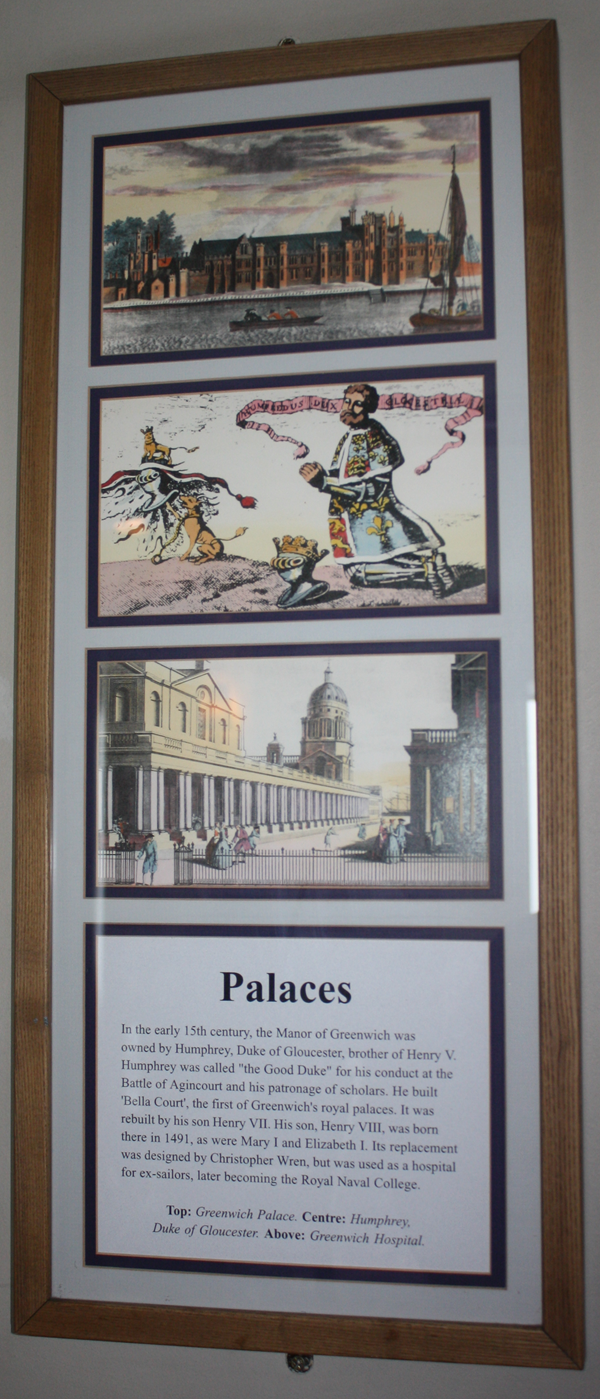
The text reads: In the early 15th century, the Manor of Greenwich was owned by Humphrey, Duke of Gloucester, brother of Henry V. Humphrey called "the Good Duke" for his conduct at the
Battle of Agincourt and his patronage of scholars. He built Bella Court, the first of Greenwich's royal palaces. It was rebuilt by his son Henry VII. His son, Henry VIII, was born there in 1491 as were Mary I and Elizabeth I. Its replacement was designed by Christopher Wren, but was used as a hospital for ex-sailors, later becoming the Royal Naval College.
Top: Greenwich Palace
Centre: Humphrey
Duke of Gloucester Above: Greenwich Hospital.
Framed prints and text about St Alfege’s.
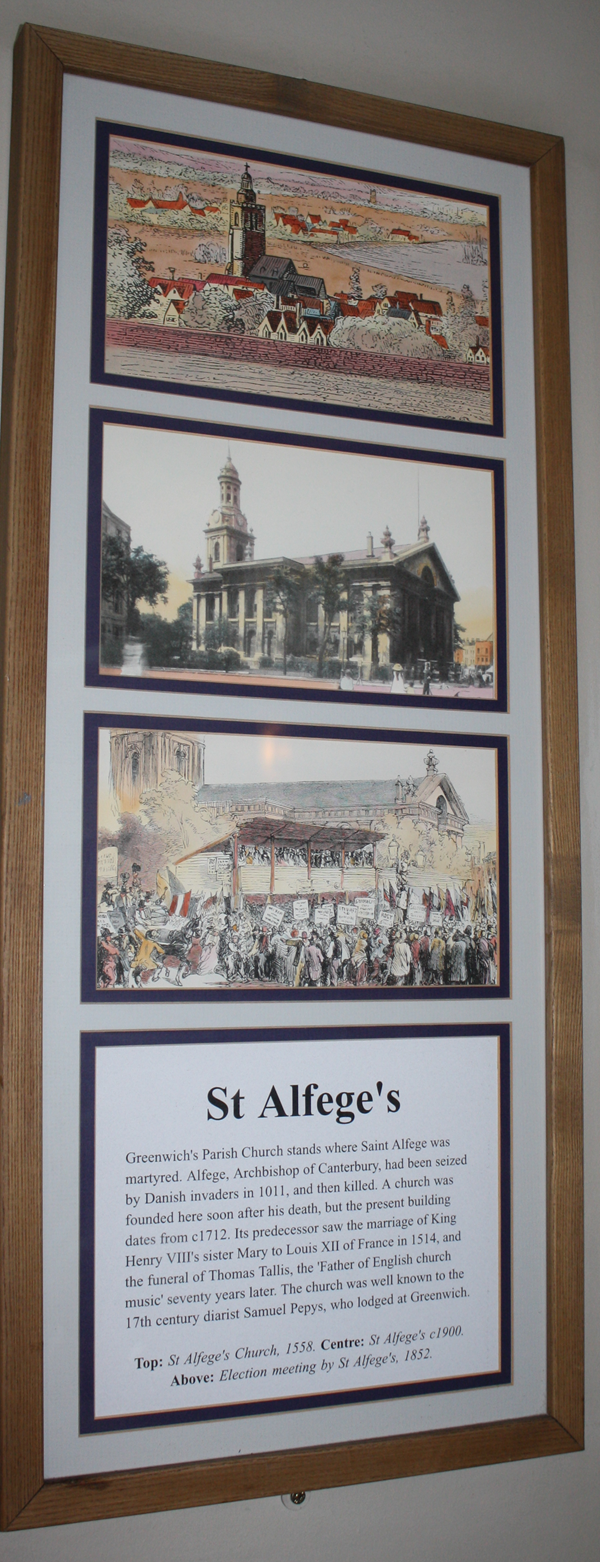
The text reads: Greenwich's Parish Church stands where Saint Alfege was martyred. Alfege, Archbishop of Canterbury, had been seized by Danish invaders in 1011, and then killed. A church was
founded here soon after his death, but the present building dates from c1712. Its predecessor saw the marriage of King
Henry VIII's sister Mary to Louis XII of France in 1514, and the funeral of Thomas Tallis, the Father of English church music' seventy years later. The church was well known to the 17th century diarist Samuel Pepys, who lodged at Greenwich
Centre: Alfege's St c1900
Top: St Alfege's Church, 1558. Alfege's, 1852
Above: Election meeting by St Alfeges, 1852.
Framed photographs and text about Indigo Jones.
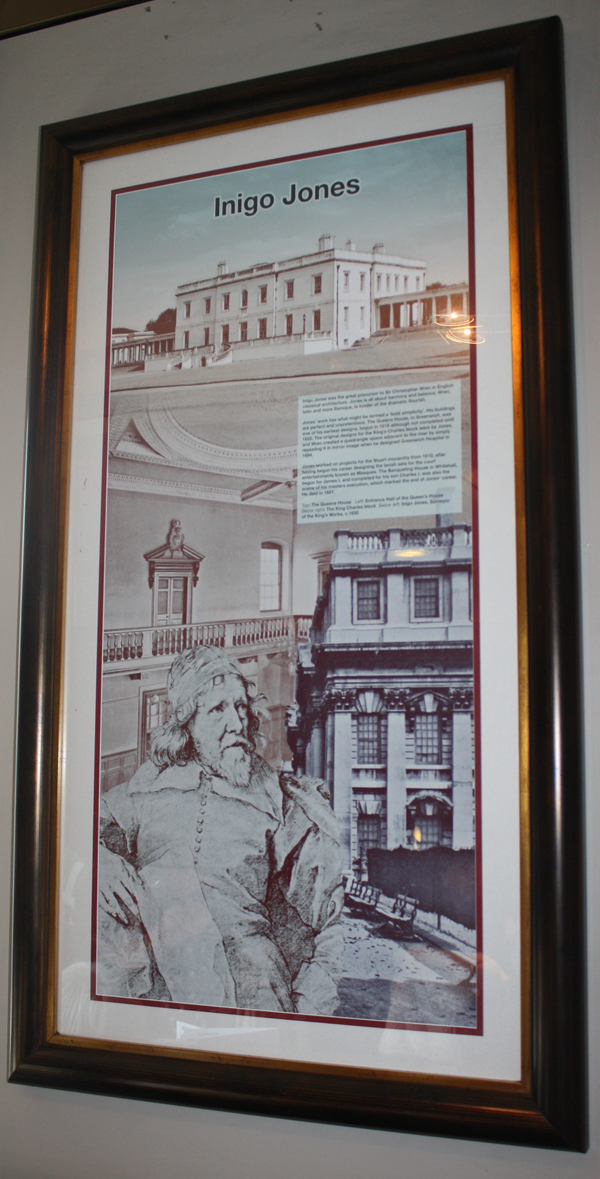
The text reads: Inigo Jones was the great precursor to Sir Christopher Wren in English classical architecture. Jones is all about harmony and balance, Wren, late and more Baroque is founder of the dramatic flourish.
Jones’ work has what might be termed ‘bold simplicity’. His buildings are perfect and unpretentious. The Queens House, in Greenwich was one of his earliest designs, begun in 1616 although not completed until 1635. The original designs for the King Charles block were by Jones and Wren created a quadrangle space adjacent to the river by simply repeating it in a mirror image when he designed Greenwich Hospital in 1694
Jones worked on projects for the Stuart monarchy from 1610, after having begun his career designing the lavish sets for the court entertainment known as masques. The Banqueting House in Whitehall begun for James I, and completed for his son Charles I, was also the scene of his, masters execution, which marked the end of Jones’ career. He died in 1651.
Top: The queens House Left: Entrance Hall of the Queen’s house
Below right: The king Charles block
Below left: Inigo Jones , surveyor of the Kings Works, c. 1630.
Framed drawings and text about Sir Christopher Wren.
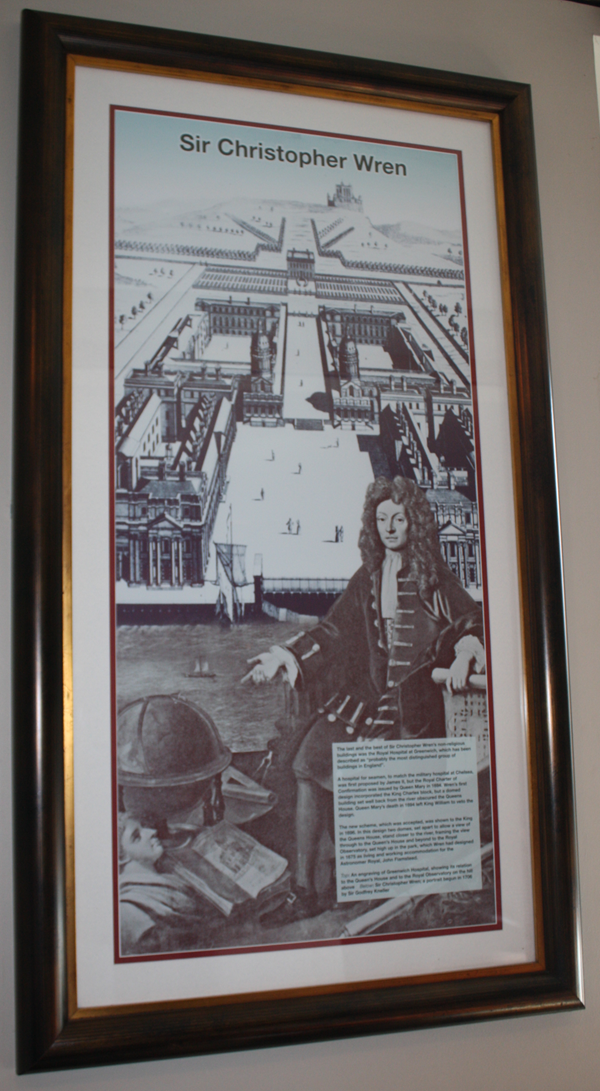
The text reads: The last and the best of Sir Christopher Wren’s non-religious buildings was the Royal Hospital at Greenwich, which has been described as “probably the most distinguished group of buildings in England”.
A hospital for seamen, to match the military hospital at Chelsea, was first proposed by James II, but the Royal Charter of Confirmation was issued by Queen Mary in 1894. Wren’s first design incorporated the King Charles block, but a domed building set well back from the river obscured the Queen’s House. Queen Mary’s death in 1894 left King William to veto the design.
The new scheme, which was accepted, was shown to the King in 1896. In this design, two domes, set apart to allow a view of the Queen’s House and beyond to the Royal Observatory, set high up in the park, which Wren had designed in 1875 as living and working accommodation for the Astronomer Royal, John Flamsteed.
Top: An engraving of Greenwich Hospital, showing its relation to the Queen’s House and to the Royal Observatory on the hill above
Below: Sir Christopher Wren; a portrait begun in 1706 by Sir Godfrey Kneller.
External photograph of the building – main entrance.
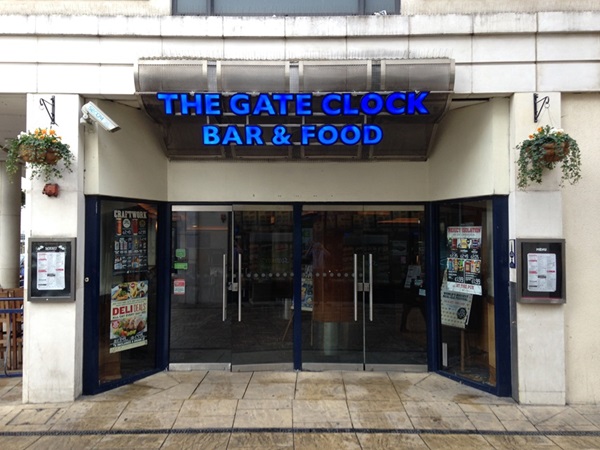
If you have information on the history of this pub, then we’d like you to share it with us. Please e-mail all information to: pubhistories@jdwetherspoon.co.uk